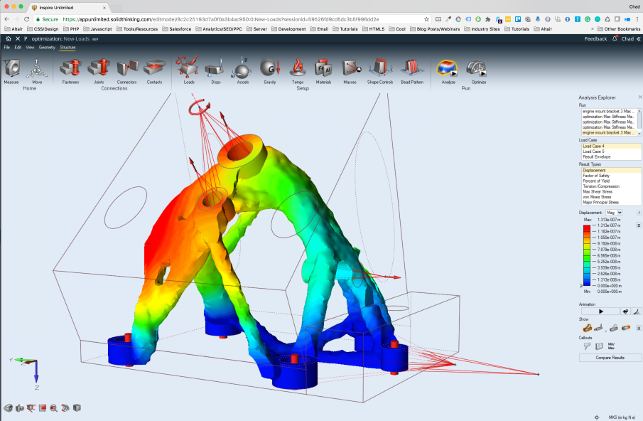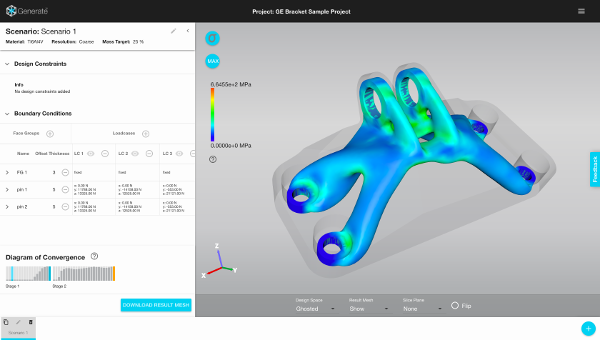solidThinking Inspire Unlimited- With growing interest in topology optimisation, solidThinking has launched an initiative to make its tools more accessible. We take a look
Long time readers of DEVELOP3D should be familiar with Altair’s solidThinking brand. It has two key products that focus on designers or design engineers.

With SolidThinking Inspire Unlimited, users can now carry out topology optimisation in the cloud
The first is solidThinking Evolve, which is a predominately surface-based modelling system in the tradition of Alias and Rhino.
The second, which perhaps takes more of the limelight these days, is solidThinking Inspire Unlimited. Built on technology from Altair’s Optistruct topology optimisation system, Inspire takes the process of topology optimisation and repackages it to focus on the designer and engineer, rather than the simulation specialist.
Inspire’s goal is provide a tool that’s quick and easy to use — quickly load up your geometry and use the solver to explore optimised geometry solutions, then work with the tools available (from solidThinking’s Evolve) to model over the top of the mesh-based results.
solidThinking Inspire Unlimited is pretty straightforward to run and the solve times, although dependent on the complexity of your study and the number of load cases (you can use multiple load cases to reach your optimised form), it’s a system that you need to spend time learning the ‘ins and outs’ of.
Additionally, as with any such technology, at the point of wider adoption, it needs a fair bit of learning to achieve the best results, which isn’t going to happen in a 30 day trial.
So it was with some interest that we learnt that solidThinking was looking to open the system up to a much wider audience by allowing them the time to explore the potential, not just for Inspire, but for topology optimisation in general.
solidThinking Inspire Unlimited to the cloud
solidThinking has taken the core technology in Inspire and reinvented it for the cloud. While some vendors might simply shoe-horn their software onto Amazon web-services, the SolidThinking team has given it some thought and taken advantage of the benefits of the cloud.
It has taken a managed data approach to build a layer of collaboration and project management on top of the core system, which essentially remains the same. So let’s explore it further.
Once you’ve signed up for the service and logged in (you can also log in using a LinkedIn or Google account), you’re presented with a model browser page, which will immediately be familiar to anyone that’s used a cloud-based service before. To the right, you have a list of filters for projects — solidThinking Inspire Unlimited allows you to share your models, so you’ll see a list of community shared models.
Hitting the “My Models” shows the ones you are currently working on. You can also filter down to any that you’re working on as part of a team.
To view any of these projects, select it and you’ll see more details (owner, comments etc. and a preview). To investigate it further, find the eye icon (which could be a little larger, if I’m honest). This will open up a window that allows you to view the model, interact with the model structure, which contains not only the end result, but the design space model, the optimised mesh as well as any subsequent modelling you or the creator have done.
Using the Shape Explorer commands, you can play with the optimisation results (to vary the form reduction levels). There are also commenting tools, which are handy if you’re working with team on a project.
It should be noted that this hasn’t actually loaded the Inspire software at all; this is a browser based viewer and collaboration tool. Of course, the thing you’re really interested in is the creation of your own projects. To do this, you begin a new project, either as a new model (where the intent is to model your own part) or upload an existing CAD file.
As solidThinking Inspire Unlimited is in open beta at the moment, you’re going to see some restrictions on how much data you can upload.
Once that’s done, you start your Inspire session. Again, this is done using the very small edit button. It’s at this point that Inspire proper is loaded as a virtualised session. Again, all in the browser, so there’s no install at all.
If you’ve used the system before, it’ll be exactly the same. If you haven’t, take a look at our previous reviews that cover the workfl ow pretty extensively.
The short version is that you define your design space (where the optimisation takes place), define your keep out regions and features that need to stay as is, define any constraints, both in terms of loading/restraint as well as form controls (symmetry etc.) and your design goals. You then set the system running.
Unlike the traditional Inspire install, this is, as you would expect, all computed in the cloud. You can close down your session and leave the cloud server (in this case, Microsoft Azure) to do the donkey work.
When complete, you’ll get a notification to tell you that the study is complete.
It’s then possible to log back into the system and view the results. Without having to fire up another session, the viewing tools allow you to dive in and see how things look. Then, when you’re ready, you fire up a proper session and run another iteration to take your project from mesh-based reference model to a more formal surface based model using the built-in tools
In conclusion
As we’ve said in this magazine for a while now, there’s a huge groundswell of interest in topology optimisation, which although driven by the additive manufacturing industry’s maturation, is also equally applicable to forms that are built in more traditional ways (casting, machining etc.).
For companies looking for ways to differentiate themselves, optimisation is ideal. Aside from the novelty of the forms themselves, there’s also real functional and performance benefit. Save weight and you save energy, save energy and you save money.
Inspire has always been impressive, particularly since the introduction of the modelling tools that allow you to generate not mesh-based, rough and ready forms, but true engineering surfaces, quickly and easily.
Yet, to be able to experiment with these types of tools, they need to be accessible and while solidThinking Inspire Unlimited is currently free, it will eventually switch to a pay per use, subscription service.
The benefit is that you can then experiment as you need, without having to invest in the software outright, which in this instance makes huge sense.
For the moment, it’s free while in beta and yes, there are limitations (your models are public) and we don’t know how it’ll be priced, but I think solidThinking is onto a winner with this move.
It’s in public beta now and there are some limitations you need to be aware of relating to data storage and upload/download.

Topology optimisation: What other options?
Topology optimisation is a huge topic of late. While the technology has been around for decades, the rise of interest in 3D printing and additive manufacturing (particularly in the metals field) have meant that more users are exploring its benefits.
Altair, solidThinking’s parent company, has been ahead of the game for a good long while. Its optistruct system has been used in the aerospace field (for example) for some time, and it’s this same core technology that is the basis for Inspire. But what else is out there?
Almost all mainstream CAD vendors have introduced topology optimisation in their products this year — Solid Edge, Inventor, Fusion 360, Creo and NX, with SolidWorks to come with the 2018 release. Each has their own take on it. Most focus on the use of FEA meshes as the end result, leaving you to use this as “inspiration” for a more manual modelling approach.
Where NX and Solid Edge differ is that they both licence their technology from a company called Frustum. Founded just a year or two ago by former Autodesk employees, Frustum has built its set of tools for topology optimisation with a key differentiator.
That being the end result isn’t a FEA-style jagged mesh, but rather a smoother, more production ready mesh. This, in turn, saves users a huge amount of effort.
What’s also interesting is that you can play with the technology without needing to buy NX or Solid Edge. It’s currently in beta, so sign up.
frustum.com
| Product | Inspire Unlimited (beta) |
|---|---|
| Company name | solidThinking |
| Price | Free until launch |







